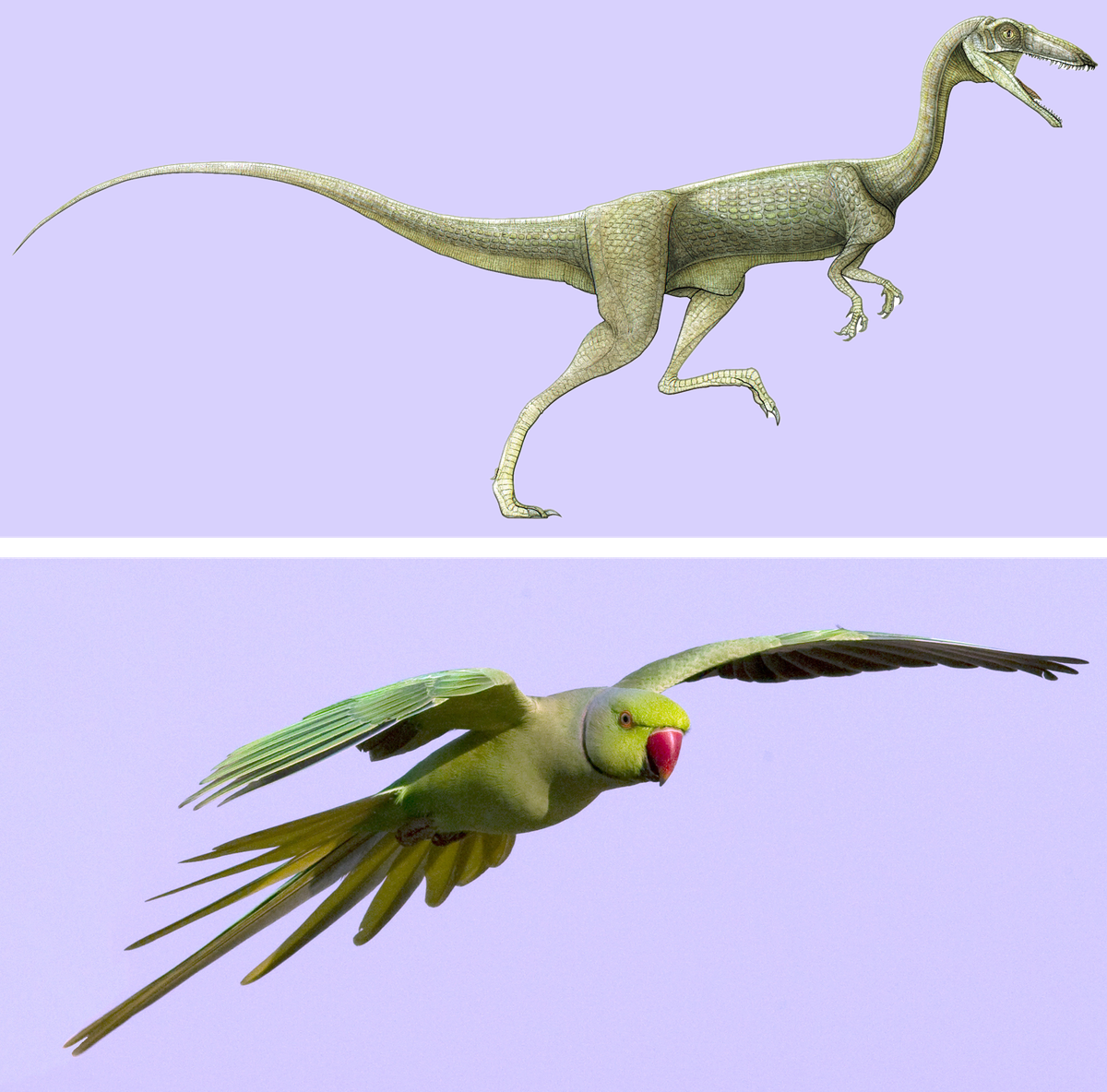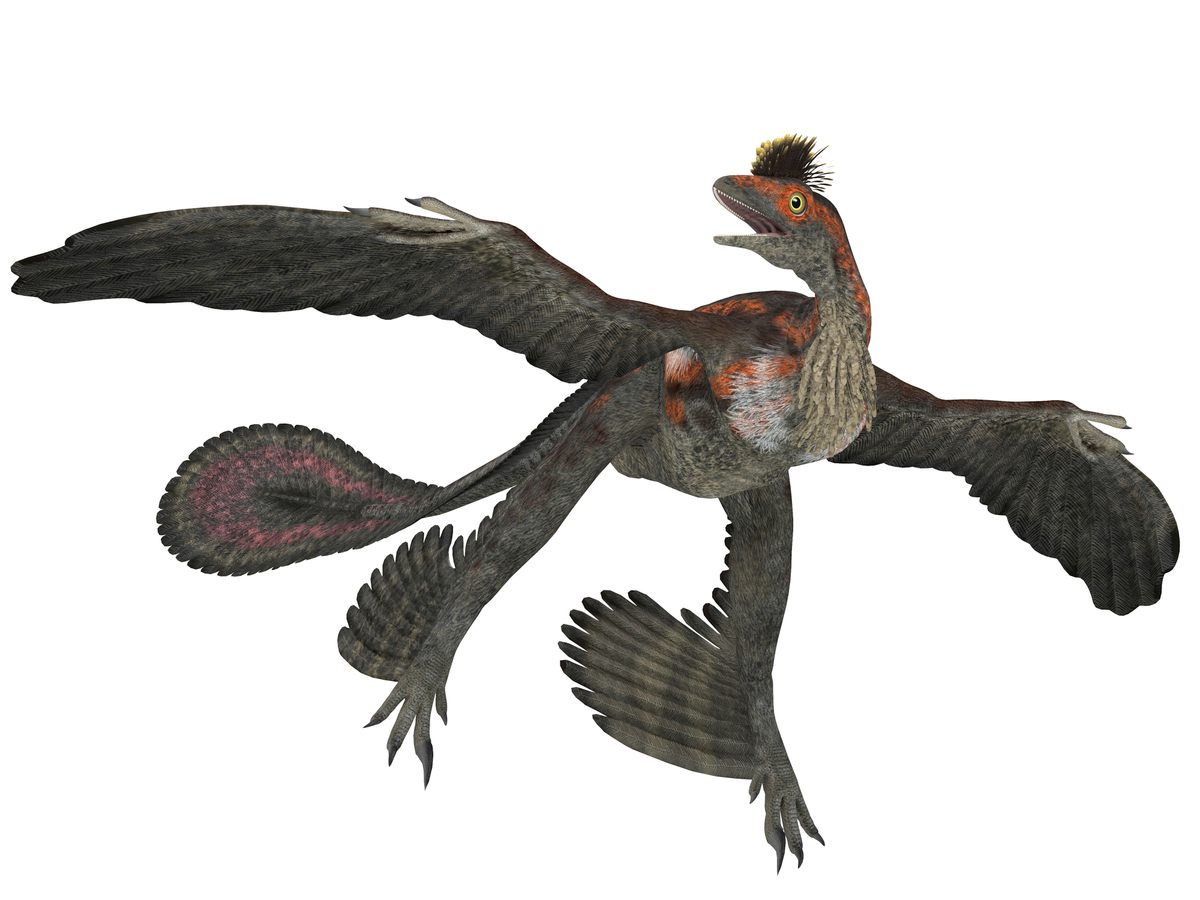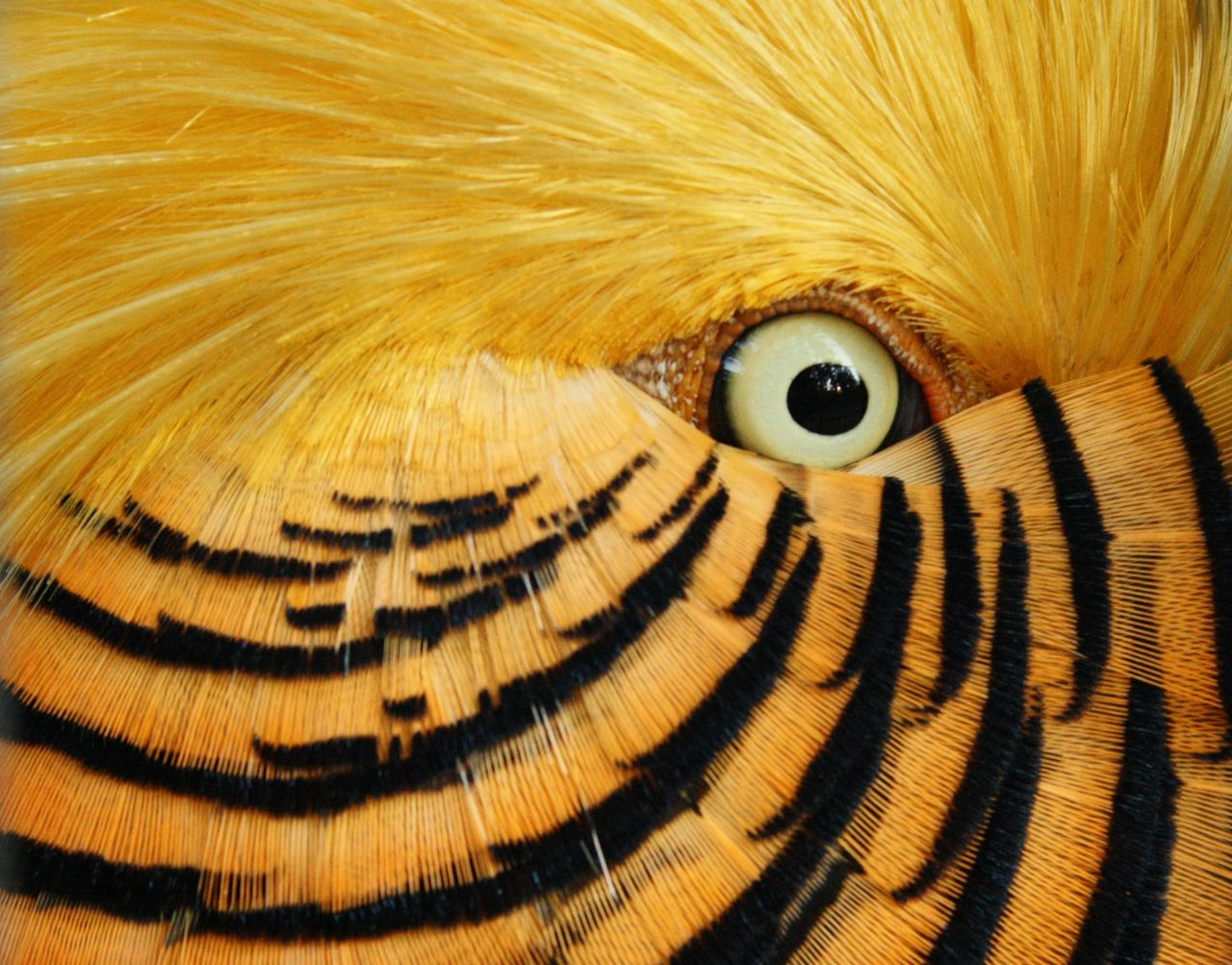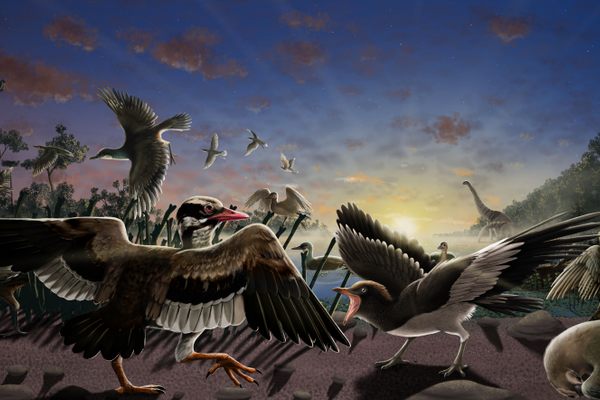We’re Surrounded by Dinosaurs, at Least We Were for a Month or So
A subtle, if temporary, change to one of the world’s biggest websites underscored a modern triumph of paleontology, and how we understand life on Earth.

Just off of East Highway 246 in the town of Solvang, California, an eye-catching sign depicts an adult male ostrich, its black and white feathers spread like the fans of a performer in a Vegas show. Just beneath the display, in big block letters: “OSTRICHLAND USA,” and “FEED THIS BAD BOY!”
Visitors who pull into the dusty parking lot and pay admission receive a dog-food bowl bolted to a metal dustpan, filled with a pellet feed. Strategically placed gaps in the fences let visitors hold up their provisions to curious ostriches and emus. The instructions are clear: Meet the birds halfway so they don’t have to strain their necks. Hold the dustpan with two hands. And don’t touch: The residents of Ostrichland USA are strong, and they bite.
I recently visited Ostrichland USA on a fall afternoon to kill time ahead of a friend’s wedding with some of the other guests. As the birds pecked at the bowls (and occasionally tried to tug them away), someone pulled up Wikipedia and began to rattle off ostrich facts. (Ostriches have only two toes on each foot! They lay the largest eggs among living land animals! They are among the small minority of bird species with penises!) Scrolling down that page also revealed a new feature for one of the world’s biggest websites, one that put the visit to Ostrichland USA—and indeed, a simple walk in the woods—in a whole new light.
In July 2023, a group of volunteer Wikipedia editors and vertebrate paleontologists began a multi-month discussion over what might seem like a small change. Every species on the website has what’s known as a “taxonomy box” that summarizes its location on the tree of life. For a blissful month, from mid-October to mid-November 2023, every single bird on Wikipedia, from the ostrich to the bee hummingbird to the gentoo penguin, was, technically, a dinosaur. Between “Phylum: Chordata” and “Class: Aves,” each bird taxonomy box included “Clade: Dinosauria.”

It was a small tweak, one that the average person who wants to learn more about the turkey vulture might not even have noticed. However, the implications for public understanding of evolution might have been surprisingly large. Wikipedia is one of the world’s most popular websites, and in making this change, it made it clearer than ever that birds are straight-up dinosaurs. Vertebrate paleontologist James Napoli, a postdoctoral researcher at the North Carolina Museum of Natural Sciences, participated in the Wikipedia discussion and saw the change as “a huge win.”
In just the past couple of weeks, however, Wikipedia seems to have gotten cold feet, and removed the “Clade: Dinosauria” labels amid a protracted debate among the site’s editors. So if I may be so bold: Wikipedia, put the labels back. Please.*
“You can become very, very different from your ancestors, but you’re still their descendants,” Napoli says. “Birds are, in every feature of their anatomy, heavily modified dinosaurs.”
This is utterly uncontroversial among paleontologists. How this became such settled science is endlessly fascinating. Decades of analysis on modern birds and ancient fossils have shown that many of the traits we once thought were unique to birds were actually inherited from non-avian ancestors.
Consider the furcula, or what we more commonly call the wishbone. This bone, equivalent to our two collar bones fused together, is found only in birds today. But furculae have been found across the part of the dinosaur family tree known as theropods, with well-preserved examples turning up in everything from the late Cretaceous titan Tyrannosaurus rex to the little Triassic scamperer Coelophysis. Wishbones appear so frequently among theropods that they probably go back to the common ancestor of all of them, which lived about 230 million years ago.

These commonalities extend to birds’ flashier features. Among living animals, birds are unique for their sometimes spectacularly colored eggshells. Chemical analyses of fossil dinosaur eggshells have shown that eggshell coloration arose among dinosaurs more than 160 million years ago.
And then there’s feathers. For the past 30 years, paleontologists have cataloged an ever-growing set of fossils, primarily from China and Mongolia, that preserve feathery, non-avian dinosaurs that lived before the emergence of powered flight. These include fuzzy, filamentous protofeathers that give us a sense of how feathers first appeared (which probably occurred before the first dinosaurs evolved).
Among some dinosaurs closely related to birds, fossils reveal quill-like “pennaceous” feathers needed for flight, as well as the pre-flight appearance of feathers on the limbs that would eventually evolve into wings. This forerunner of the wing is “something that evolved in dinosaurs for another purpose,” says paleontologist Jingmai O’Connor, the associate curator for fossil reptiles at the Field Museum of Natural History in Chicago. “Evolution hijacks the structure for a new function.”
Multiple lineages of dinosaur arrived at this hijacking independently. Flight appears to have evolved multiple times among dinosaurs. The feathered Jurassic dinosaur Microraptor, for example, seems to have been able to fly, but it was more closely related to Velociraptor than it is to living birds.
This is not to say that birds aren’t doing their own thing. Only the most bird-like dinosaur lineages display more of the hallmark features we associate with birds today: short, fused tails (known as pygostyles) and the keels on their sternums, which anchor the powerful pectoral muscles used for the wings’ downstroke during flight. And some lineages of now-extinct but unmistakable birds, such as the enantiornithines, had tiny toothy snouts. “Becoming a bird is a gradual process,” says paleontologist Daniel Ksepka, the curator for science at the Bruce Museum in Greenwich, Connecticut.

Our familiarity with modern birds, and the millions upon millions of years since the Jurassic, can make this deep dinosaurian heritage difficult to process. It can be hard to see sparrows and eagles for what they really are, especially if your mental images of extinct dinosaurs trend toward the non-avian Stegosaurus and Triceratops, which fall on the opposite end of the family tree from birds.
Many of us of a certain age grew up learning that birds are birds, reptiles are reptiles, and that each had its place in the hierarchical Linnaean classification system: kingdom, phylum, class, order, family, genus, species. By this classic scheme, birds and reptiles are considered as separate categories of animals. But based on what we know of evolution, that’s not right.
The first reptiles arose more than 300 million years ago, and over the next tens of millions of years, they survived Earth’s worst mass extinction and diversified tremendously. This yielded a dazzling array of creatures: lizards (including snakes), all sorts of extinct marine reptiles, a vast menagerie of pseudosuchians (of which only crocodilians remain), and the winged creatures known as pterosaurs. This tally also includes dinosaurs, which arrived on the scene more than 230 million years ago as bipedal, probably warm-blooded critters about the size of today’s dogs.
Dinosaurs then diversified themselves, with the ancestors of birds among those branches, and they, too, blossomed. Taking the long view, birds are very much reptiles but are heavily, heavily modified.
The classic classification scheme captures none of this nuance because it “was never intended to exist in the context of evolution,” says Skye McDavid, an independent paleontologist and scientific illustrator affiliated with the Delaware Valley Paleontological Society, who participated in the Wikipedia discussion. Carl Linnaeus, the 18th-century Swedish biologist whose enormous system became the European standard, was a devout creationist working a century before Charles Darwin and Alfred Russell Wallace popularized the theory of natural selection. Of course he saw hierarchy—immutable and divinely created. There was never any worry about one group giving rise to another. In reality, the web of life turned out to be more tangled and complex than his system was built for.

As a result, biologists have long adapted the Linnaean classification system to accommodate new evolutionary findings, adding all sorts of bells and whistles to the scheme: domains, superorders, infraclasses, subfamilies. Nowadays, many working taxonomists have abandoned the strictness of Linnaean hierarchy in favor of “clades”: neutral nesting groups that mirror the branching path of evolution, regardless of what that means for the old classification system. The clade Aves sits within the clade Dinosauria, which in turn nests within the clade Reptilia, all in line with the groups’ shared evolutionary history. No muss, no fuss.
Crucially, that tiny little Wikipedia change—the one that Wikipedia should reinstate—reflects the entire world of this evolutionarily informed, post-Linnaean view. “We’re getting closer to the true representation of nature,” says Julia Clarke, a paleontologist at the University of Texas at Austin.
The more you think about this, the more enchanting it becomes. There are more than 10,000 species of living birds, making them the most diverse group of terrestrial vertebrates on the planet today. The Age of Dinosaurs never really ended. During World War I and World War II, armies used dinosaurs to send messages to and from the front lines. In folklore around the world, dinosaurs deliver bundled-up babies to expecting parents. And on the side of a California highway, you can even feed one of those bad boys.
* Update: This story was revised after publication when it became clear that Wikipedia had reversed the change. Fingers crossed that it will come back.
Michael Greshko is an award-winning science journalist based in Washington, D.C., who loves to explore the fossil record and life’s great evolutionary story.














Follow us on Twitter to get the latest on the world's hidden wonders.
Like us on Facebook to get the latest on the world's hidden wonders.
Follow us on Twitter Like us on Facebook